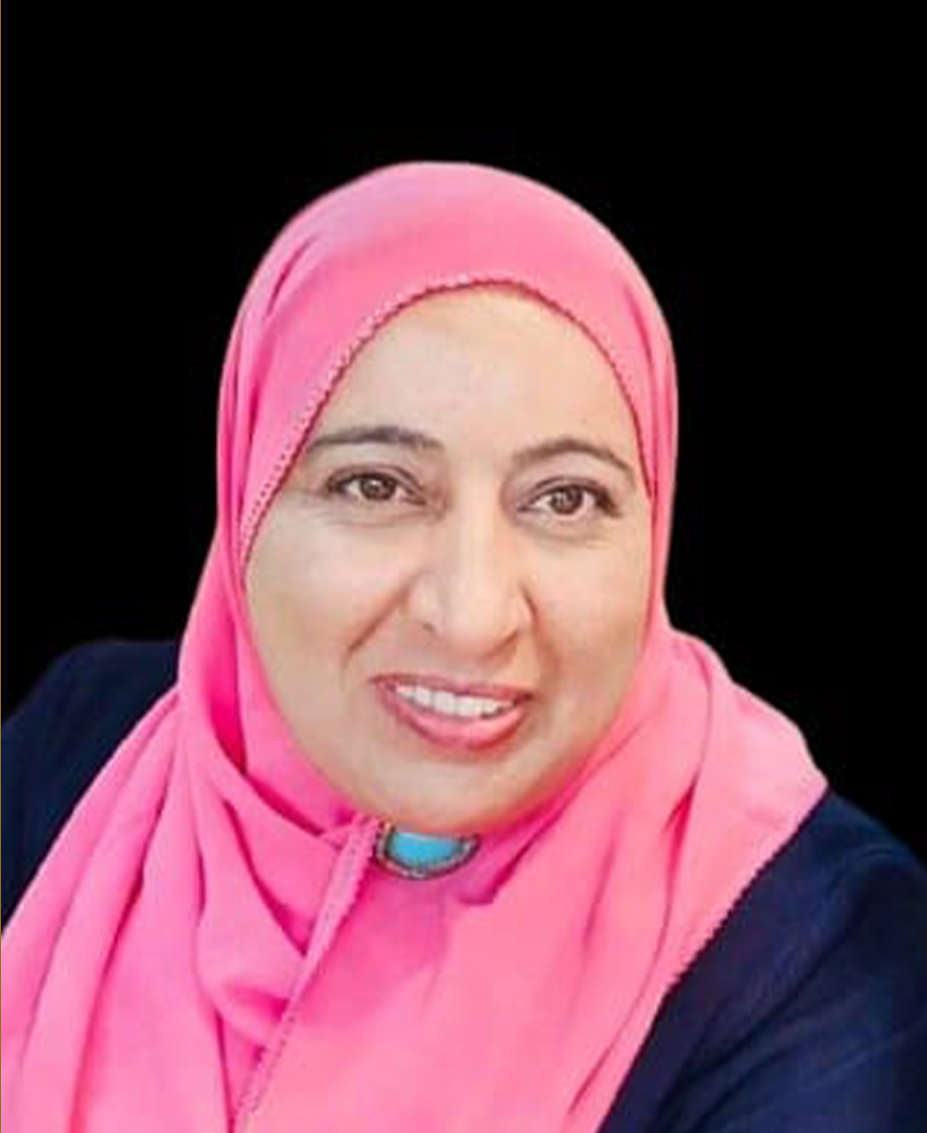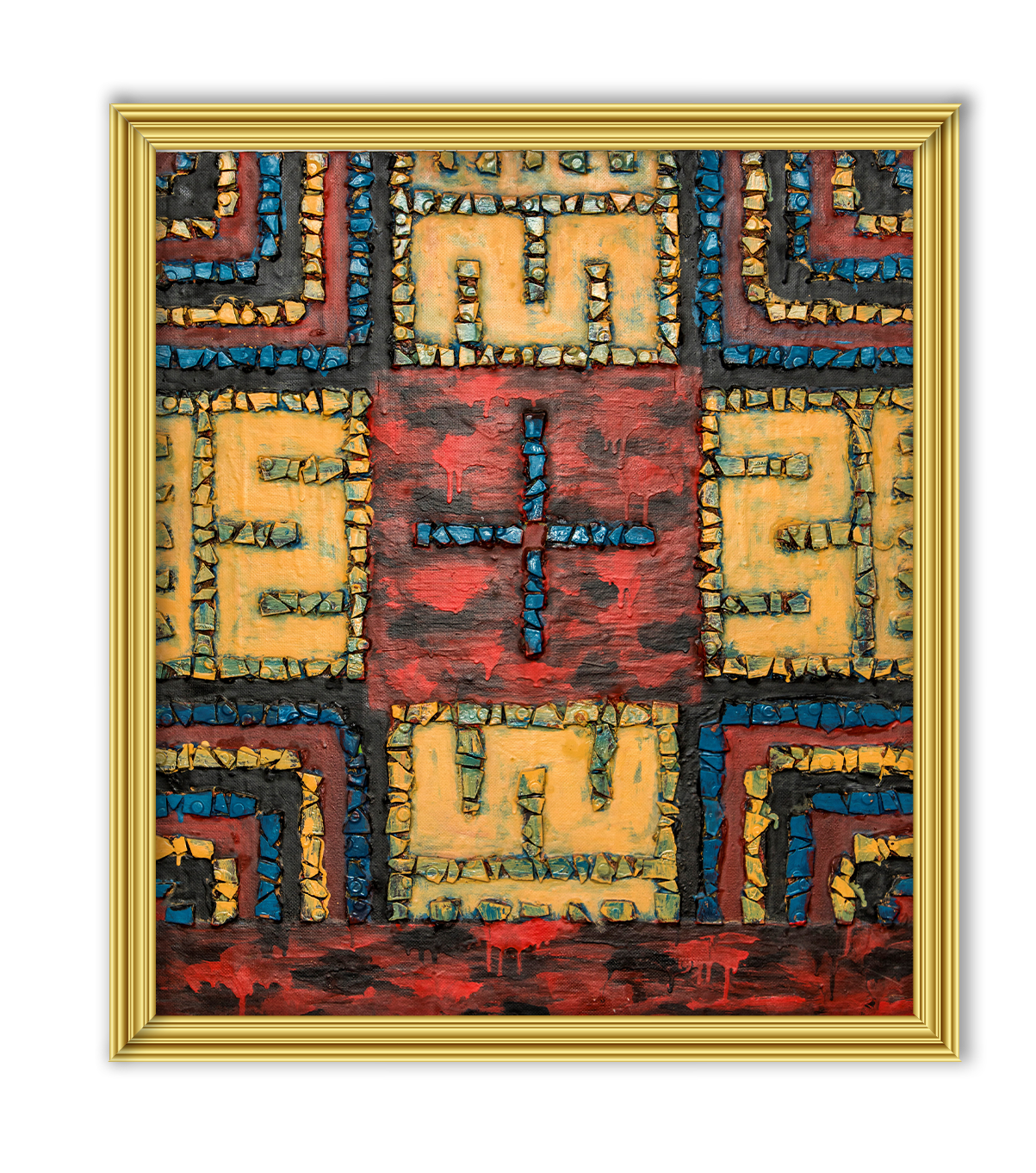بين الدوالي” من قبل الفنان ميادة المصري”


Mayada Al-Masri
Born: 1972, Kfar Qara
Professional Education
1995 Special Education, Menashe College
1996-1998 Art, The Arara Art Center
1999 Studies in Creativity as an Educational Tool for People with Special Needs.
2001 Completion of Studies in Art Therapy, Givat Haviva
2005 Art History, Arara Arts Center
2014 B.A. in Learning Disabilities, Open University
2014 Teaching Certificate in Learning Disabilities, Sakhnin Teachers Training College
Employment
1996- Counselor at Kfar Qara Family Center
A Selection of Group Exhibitions
1996 “Creative Women,” Umm el-Fahem Art Gallery
1996 “A Different Perspective,” Kfar Qara Cultural Center
1997 “The Arab Artists,” Umm el-Fahem Art Gallery
1998 “The Festival of Paintings,” Arara Art Center
1999 “Arab Work-Hebrew Work,” Uri & Rami Nehushtan Museum, Kibbutz Ashdot Yaacov Meuchad
1999 “Creative Artists Inspired by Ethnic Tradition,” Mishkanot Sha’ananim Music Center, Jerusalem
1999 “Letter and More,” Beit Hagefen Art Gallery, Haifa & the Umm el-Fahem Art Gallery
1999 “Arab Work-Hebrew Work,” Kfar Saba Municipal Gallery
2000-2001 “Stones Speak Peace,” Traveling Exhibition. Curator: Doron Pollack:
Tel Aviv Opera House; Jaffa Festival; Venice Biennale; Aachen, Germany; Lodz Museum, Poland
2000 “Embroidering Connection,” Municipal Gallery, Nes Tziona Cultural Compound; the Umm el-Fahem Art Gallery
2000 “The Thread that Connects,” Department of Art, Tel Aviv University (within the framework of an international conference)
2000 “Local Document,” The Villa – Center for Contemporary Art, Tel Aviv
2000 “Verbatim,” Kaye College Gallery, Beersheba
2000 “Mythologies,” Umm el-Fahem Art Gallery
2000 “2000: From One Millennium to the Next,” Gallery for Concrete Art, Tel Aviv
2001-2002 “Fields,” traveling exhibition, Popular Art Association
2003 Participated in the First “Feeling Turmoil Festival,” Kfar Qara
2004 “Light & Shade,” Beit Hagefen Art Gallery, Haifa
2007 “Future Memory,” Paris
2008 “The Feminine Voice from Afar,” (within the framework of the 2008 Women’s Festival), Hankin Gallery, Holon
2015 “Creative Women,” ceramic art, Umm el-Fahem Art Gallery
2016 “Process of Giving,” Umm el-Fahem Art Gallery
2016 “Colorful Spectacles (within the framework of the Tree of Culture Festival), Al-Houarna Center, Kfar Qara
2017 “Palestine Story & Color” (within the framework of the 5th International Exhibition), Al-Najakh University, Nablus (Palestinian Authority)
2017 Participated in The Jordan Festival for Contemporary Art, Aqaba (Jordan)
Solo Exhibition
2004 “Among Grapevines,” Bethlehem Peace Center (Palestinian Authority)
التعليم المهني
1995 التربية الخاصة ، كلية منشيه
1996-1998 مركز أرارا للفنون
1999 دراسات في الإبداع كأداة تعليمية لذوي الاحتياجات الخاصة.
2001 الانتهاء من دراسات العلاج بالفن
2005 تاريخ الفن مركز ارارة للفنون
2014 بكالوريوس في صعوبات التعلم ، الجامعة المفتوحة
2014 شهادة تدريس في صعوبات التعلم ، كلية تدريب المعلمين في سخنين
الوظائف
مركزة النادي العائلي كفرقرع
مجموعة مختارة من المعارض الجماعية
١٩٩٦ “كريتف ومن,” أم الفهم أرت جاليري
“من زاوية أخرى “، مركز كفرقرع الثقافي، 1996
” الفنانون العرب “، صالة العرض للفنون، ام الفحم، 1997
“مهرجان الفنون الأول ” مركز الفنون – عرعرة، 1998
1999 “Arab Work-Hebrew Work,” Uri & Rami Nehushtan Museum, Kibbutz Ashdot Yaacov Meuchad
1999 “Creative Artists Inspired by Ethnic Tradition,” Mishkanot Sha’ananim Music Center, Jerusalem
1999 “رسالة وأكثر” ، صالة بيت هاجفين للفنون ، حيفا وصالة أم الفحم للفنون
1999 “العمل العربي – العمل العبري” ، صالة عرض بلدية كفار سابا
“حجارة تحكي السلام ” معرض متجول في داخل وخارج البلاد، المنسق دورن بولاك ، 2001-2000
دار الأوبرا في تل أبيب ؛ مهرجان يافا بينالي البندقية آخن ، ألمانيا ؛ متحف لودز ، بولندا
2000 “وصلة تطريز” ، صالة عرض البلدية ، مجمع نيس تزيونا الثقافي ؛ – صالة أم الفحم للفنون
2000 “الخيط الذي يربط” قسم الفنون ، جامعة تل أبيب (في إطار مؤتمر دولي)
2000 “وثيقة محلية” الفيلا – مركز الفن المعاصر ، تل أبيب
2000 معرض حرفي بكلية كاي بئر السبع
“ميثولوجيص,” أم الفهم أرت جاليري 2000
2000 “2000: من ألفية واحدة إلى أخرى” ، صالة عرض للفن الخرساني ، تل أبيب
2001-2002 “الحقول” ، معرض متنقل ، جمعية الفن الشعبي
2003 المشاركة في “مهرجان الشعور بالاضطراب” كفر قرع
“ضوء وظل “، شهر الثقافة – بيت الكرمة، حيفا، 2004
2007 “ذاكرة المستقبل” باريس
“صوت نسوي من بعيد “، مركز الثقافة والفنون، حولون، 2008
” نساء مبدعات “، فن السراميك، صالة العرض للفنون، ام الفحم، 2015
“مسيرة عطاء ” صالة العرض للفنون، ام الفحم
“مهرجان شجرة الثقافة ” ، معرض ” رؤى ملونة ” ، المركز الثقافي الجماهيري الحوارنة ، كفرقرع
” فلسطين حكاية ولون” كلية الفنون الجميلة، جامعة النجاح، نابلس، 2017
2017 المشاركة في مهرجان الأردن للفن المعاصر ، العقبة (الأردن)
معارض فردية
The exhibition
“Among the Grapevines,” “Bin al-Duali” in Arabic, is an expression we associate with the traditional song “Bin al-Duali wa-al-Krm al-A’ali” (“Among the Grapevines and the High Vineyard”).
This heading takes us back our childhood, when we would flee the summer heat and gather together under the shade the grapevines afforded. This shade, which embraces the childhood memories of Artist Mayyada Masry, continues to serve as a nostalgic symbol for those happy childhood days. The memories also serve as inspiration for Masry’s works. Of course, the personal symbol serves at the same time as a collective symbol of Palestinian identity.
Masry utilizes vine leaves, used to prepare a tasty dish, adopting them in her artistic work as a base hidden under colors. In using vine leaves as a base for works decorated with threads and words, she reinvigorates her memories. The vine leaf hovers between presence and absence1 as though transformed into the earth/the source of life.
As Artist Mayyada Masry confided in me during our series of ongoing sessions, she stands in awe of vine leaves, an ethnic dish she prepares by herself; they still excite her. Like the dish itself, the preparation for which requires an investment of special efforts, expertise and dedication, the artist’s works are the result of a complex, multi-stage technique.
She has researched the raw materials in her laboratory – her studio – examining whether vine leaves and fig leaves could be used appropriately as a background and base for her works. After carrying out many experiments, as part of an ongoing process of trial and error, she concluded that vine leaves spoke to her best, since they are soft and malleable and, as opposed to fig leaves, it is easy to fold and roll them. In addition, as the artist states: “Vine leaves are close in form to the shape of a pentagonal star.”
Masry experimented in her studio with coloring, tearing and drying vine leaves, and with regenerating them too, a process resembling deconstruction and reconstruction, by means of which she hoped to formulate a new experience with an innovative identity and indications. Her work includes vine leaves decorated with embroidery thread and words – three symbols that undergo a process of simplification. The artist isolates a single Palestinian embroidery stitch and enlarges it, and by this act it becomes something in its own right – a painting on the spectacularly colored background to which it has been applied.
In Akra (“Read” in English), a work named after the opening word of the Al-Alaq surah, the word itself is transformed into a philosophical message, calling on the viewer to study and examine the work. Nevertheless, we can also interpret it as a call to relate to the political situation.In this context, the call is not for this to be implemented by the physical, biological eye, but by the heart’s eye, by wisdom, as defined by Al-Ghazali (the medieval Muslim theologian and philosopher). In order for the viewer to read the painting, he or she must move closer to it, to be able to see the branches and leaves interwoven in it with color and thread. Only then can the significance hidden behind what is obvious, be revealed, a significance that gives presence to tradition/the past, as well as to the interweaving among language, identity, land and nation.
Other artists – and not just Palestinians – have used vine leaves in their works; Nabil Anani is one case in point. Anani painted a Palestinian woman surrounded by a halo in the shape of a vine branch. In so doing, he added a facet of sanctity to the mythic connection of woman, land and nation.
However, Anani draws vine leaves, he does not use them as a raw material, the way Masry does. The viewer sees each element individually in Anani’s painting – the woman, the vine leaves and the embroidered clothing. In contrast, the elements in Masry’s abstract works cannot be isolated, each one is a symbol, and eliminating any one of them detracts from the work’s very significance.
هذا العنوان يعيدنا إلى طفولتنا ، عندما نهرب من حر الصيف و تجمع العنب تحت الظل ممنوحة. هذا الظل ، الذي يحتضن ذكريات الطفولة للفنانة ميادة المصري ، لا يزال بمثابة رمز الحنين إلى أيام الطفولة السعيدة. الذكريات أيضا بمثابة مصدر إلهام لأعمال المصري. بالطبع ، يعمل الرمز الشخصي في نفس الوقت كرمز جماعي للهوية الفلسطينية.
تستخدم المصري ورق العنب لتحضير طبق لذيذ ، تتبناها في عملها الفني كقاعدة مخفية تحت الألوان. باستخدام أوراق العنب كأساس للأعمال المزينة بالخيوط والكلمات ، فإنها تنعش ذكرياتها. ورق العنب يحوم بين الوجود والغياب كما لو أنه تحول إلى الأرض / مصدر الحياة.
كما أسرتني الفنانة ميادة مصري خلال سلسلة جلساتنا المستمرة ، فهي تقف في رهبة من ورق العنب ، وهو طبق شعبي تعده بنفسها مثل الطبق نفسها ، التي يتطلب التحضير لها استثمار جهود خاصة وخبرة وتفاني ، أعمال الفنانة هي نتيجة تقنية معقدة متعددة المراحل.
لقد بحثت في المواد الخام في مختبرها – الاستوديو الخاص بها – لفحص ما إذا كان من الممكن استخدام أوراق العنب وأوراق التين بشكل مناسب كخلفية وأساس لأعمالها. بعد القيام بالكثير التجارب، كجزء من عملية مستمرة للمحاولة و الخطأ، وخلصت إلى أن أوراق العنب أفضل ما لديها ، حيث أنها ناعمة ومرنة ، وعلى عكس أوراق التين ، من السهل طيها ولفها. بالإضافة إلى ذلك ، كما تقول الفنانة : “أوراق العنب قريبة في شكلها من شكل نجمة خماسية.”
جربت مصرية في الاستوديو الخاص بها تلوين أوراق العنب وتجفيفها ، وتجديدها أيضًا ، وهي عملية تشبه التفكيك وإعادة البناء ، وتأمل من خلالها صياغة تجربة جديدة بهوية ومؤشرات مبتكرة. يشمل عملها ورق عنب مزين بخيوط تطريز وكلمات ثلاثة رموز تخضع لعملية تبسيط. تعزل الفنانة غرزة تطريز فلسطينية واحدة ويكبرها ، وبهذا الفعل يصبح شيئًا بحد ذاته – لوحة على الخلفية الملونة المذهلة التي طبقت عليها.
في (“اقرأ”) ، وهو عمل سمي على اسم الكلمة الافتتاحية لسورة العلق ، تتحول الكلمة نفسها إلى رسالة فلسفية تدعو المشاهد إلى دراسة العمل وفحصه. ومع ذلك ، يمكننا أيضًا تفسيرها على أنها دعوة تتعلق بالوضع السياسي ، وفي هذا السياق ، فإن الدعوة ليست لهذا الأمر. بالعين الجسدية والبيولوجية ولكن بالعين القلبية ، بالحكمة كما عرّفها الغزالي (عالم اللاهوت والفيلسوف المسلم في العصور الوسطى). لكي يقرأ المشاهد اللوحة ، يجب عليه الاقتراب منها ، حتى يتمكن من رؤية الأغصان والأوراق المتشابكة فيها بالألوان والخيط. عندها فقط يمكن الكشف عن المغزى المخفي وراء ما هو واضح ، وهو مغزى يعطي حضورًا للتراث/ الماضي ، بالإضافة إلى تتشابك بين اللغة والهوية والأرض والأمة.
فنانون آخرون – وليس الفلسطينيون فقط – استخدموا أوراق العنب في أعمالهم. نبيل عناني مثال على ذلك. رسم عناني امرأة فلسطينية محاطة بهالة على شكل غصن كرمة. وبذلك ، أضاف وجهًا من القداسة إلى العلاقة الأسطورية بين المرأة والأرض والأمة.
لكن عناني يرسم أوراق العنب ، ولا يستخدمها كمادة خام ، كما تفعل المصري. يرى المشاهد كل عنصر على حدة في لوحة عناني – المرأة ، ورق العنب ، والملابس المطرزة.
Written by Dr. Aida Nasrallah – Palestine
store Shop now
The Expo

